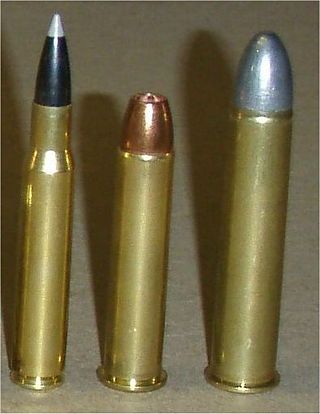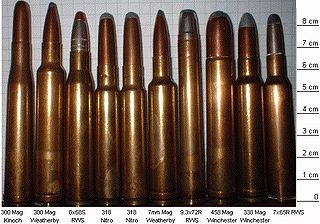
An elephant gun is a large caliber gun, rifled or smoothbore, originally developed for use by big-game hunters for elephant and other large game. Elephant guns were black powder muzzle-loaders at first, then black powder express rifles, then later used smokeless powder cartridges.

The .460 Weatherby Magnum is a belted, bottlenecked rifle cartridge, developed by Roy Weatherby in 1957. The cartridge is based on the .378 Weatherby Magnum necked up to accept the .458-inch (11.6 mm) bullet. The original .378 Weatherby Magnum parent case was inspired by the .416 Rigby. The .460 Weatherby Magnum was designed as an African dangerous game rifle cartridge for the hunting of heavy, thick skinned dangerous game.

The 7×57mm Mauser is a first-generation smokeless powder rimless bottlenecked rifle cartridge. It was developed by Paul Mauser of the Mauser company in 1892 and adopted as a military cartridge by Spain in 1893. It was subsequently adopted by several other countries as the standard military cartridge, and although now obsolete as a military cartridge, it remains in widespread international use as a sporting round. The 7×57 Mauser was a popular stalking cartridge and sporting rifles in this chambering were made by the famous British riflemakers, such as John Rigby, Holland and Holland, Westley Richards and others. British cartridge nomenclature designated caliber in inches, and the cartridge was known as the .275 bore after the measurement of a 7 mm rifle's bore across the lands.

The double rifle, also known as a double-barreled rifle, is a rifle with two barrels mounted parallel to each other that can be fired simultaneously or sequentially in quick succession. Synonymous with big game hunting found primarily in Africa and Asia, the double rifle is a sporting weapon with very little military heritage.

The .45-70, also known as the .45-70 Government, .45-70 Springfield, and .45-21⁄10" Sharps, is a .45 caliber rifle cartridge originally holding 70 grains of black powder that was developed at the U.S. Army's Springfield Armory for use in the Springfield Model 1873. It was a replacement for the stop-gap .50-70 Government cartridge, which had been adopted in 1866, one year after the end of the American Civil War, and is known by collectors as the "Trapdoor Springfield".

The .458 Winchester Magnum is a belted, straight-taper cased, Big Five game rifle cartridge. It was introduced commercially in 1956 by Winchester and first chambered in the Winchester Model 70 African rifle. It was designed to compete against the .450 Nitro Express and the .470 Nitro Express cartridges used in big bore British double rifles. The .458 Winchester Magnum remains one of the most popular large game cartridges, and most major ammunition manufacturers offer a selection of .458 ammunition.
The .416 Rigby is a rifle cartridge designed in 1911 by London based gunmaker John Rigby & Company, for hunting dangerous game. It is the first cartridge to use a bullet of .416 inch diameter. The rifles, as built by John Rigby & Co., were initially made up on the Magnum Mauser 98 action, although in later years, some were made on standard length actions, a perfect example being the rifle used by legendary professional hunter Harry Selby. Other famous users of the cartridge were Commander David Enderby Blunt, John Taylor, and Jack O'Connor.

The .700 Nitro Express (17.8×89mmR) is a big game rifle cartridge. The cartridge is typically charged with around 250 grains of powder, in addition to a two-grain igniter charge. The cartridge was introduced in 1988 by the boutique gunmakers Holland & Holland (H&H) of London. It was developed by Jim Bell and William Feldstein and built by H&H. Feldstein had tried unsuccessfully to get H&H to build a .600 Nitro Express for him, but they had already ceased production. However, when Bell and Feldstein produced an entirely new .700 Nitro Express cartridge, they were able to attract the interest of H&H, which was looking for a new big-bore cartridge. After production began, the backlog of orders was so great that it continued to 2007 and H&H restarted the production of .600 Nitro Express guns.

The Nitro Express (NE) series of cartridges are used in large-bore hunting rifles, also known as elephant guns or express rifles, but later came to include smaller bore high velocity British cartridges.
The .577 Nitro Express is a large-bore centerfire rifle cartridge designed for the purpose of hunting large game such as elephant. This cartridge is used almost exclusively in single-shot and double express rifles for hunting in the Tropics or hot climates in general and is a cartridge associated with the golden age of African safaris and Indian shikars.

The .375 H&H Magnum, also known as .375 Holland & Holland Magnum, is a medium-bore rifle cartridge introduced in 1912 by London based gunmaker Holland & Holland. The .375 H&H cartridge featured a belt to ensure the correct headspace, which otherwise might be unreliable, given the narrow shoulder of the cartridge case. The cartridge was designed to use cordite which was made in long strands – hence the tapered shape of the case, which, as a beneficial side effect also helped in smooth chambering and extraction from a rifle's breech.

The 9.5×57mm Mannlicher–Schönauer (MS) cartridge was adopted for the M-1910 MS rifle and carbine in 1910. The 9.5×57mm MS is also known as the 9.5×56mm MS, the 9.5×56.7mm MS, and the .375 Rimless Nitro Express (RNE) × 2¼. The cartridge may have been created by Westley-Richards and Eley in 1908, but no production rifles in this caliber have been found prior to the M-1910. This development by or on behalf of Steyr was probably an answer to the development by the noted British gunmaking firm of Holland & Holland in 1905 of their .400/375 Belted Nitro Express, designed for their specially modified Mannlicher–Schoenauer rifle. Whether the development of the 9.5×57mm Mannlicher–Schoenauer cartridge originated with OWS or with Holland's British competitor, Westley Richards certainly was the principal promoter of the new 1910 Model Mannlicher–Schoenauer rifle as evidenced by catalogs of the time. The 9.5×57mm MS is the last pre-war proprietary cartridge by Steyr and their most powerful until the recent advent of the .376 Steyr, which has its antecedents in the 9.5×57mm.
The .500/450 Magnum Nitro Express is a large bore centerfire rifle cartridge developed by Holland & Holland.

The .404 Jeffery is a rifle cartridge designed for hunting large, dangerous game animals, such as the "Big Five" of Africa. The cartridge is standardized by the C.I.P. and is also known as .404 Rimless Nitro Express. It was designed in 1905 by London based gunmaker W.J. Jeffery & Co to duplicate the performance of the .450/400 Nitro Express 3-inch in bolt-action rifles. The .404 Jeffery fired a bullet of .422 in (10.72 mm) diameter of either 300 gr (19 g) with a muzzle velocity of 2,600 ft/s (790 m/s) and muzzle energy of 4,500 foot-pounds force (6,100 N⋅m) or 400 gr (26 g) with a muzzle velocity of 2,150 ft/s (660 m/s) and 4,100 foot-pounds force (5,600 N⋅m) of energy. It is very effective on large game and is favored by many hunters of dangerous game. The .404 Jeffery was popular with hunters and game wardens in Africa because of its good performance with manageable recoil. By way of comparison, the .416 Rigby and .416 Remington Magnum cartridges fire .416 in (10.57 mm) bullets of 400 gr at 2,400 feet per second (730 m/s) with a muzzle energy of approximately 5,000 foot-pounds force (6,800 N⋅m). These cartridges exceed the ballistic performance of the .404 Jeffery but at the price of greater recoil and, in the case of the .416 Rigby, rifles that are more expensive.

The .458 Lott is a .458 caliber rifle cartridge designed for the purpose of hunting large, thick-skinned dangerous game animals in Africa. It is based on the full length .375 H&H Magnum case blown out and shortened to 2.800 inches (71.1 mm).

The .500 Nitro Express is a rifle cartridge designed for hunting large and dangerous game animals in Africa and India. This cartridge was primarily designed for use in double rifles though various single shots were produced on the Farquarson action and at least one major company (Heym) produced it in bolt-action configuration. It was commonly available in two lengths: a 3.00 in (76 mm) and a 3.25 in (83 mm) version.
The .333 Jeffery and .333 Jeffery Flanged are medium-bore rifle cartridges developed by W.J. Jeffery & Co and introduced in 1908.
The .350 Rigby and .350 Rigby No 2 are proprietary medium bore rifle cartridges developed by John Rigby & Company.
The .400/350 Nitro Express, also known at the .400/350 Nitro Rigby, is a medium bore rifle cartridge developed by John Rigby & Company.
The .400/360 Nitro Express cartridges are a number of very similar, but not interchangeable, centerfire rifle cartridges developed by James Purdey & Sons, William Evans, Westley Richards and Fraser of Edinburgh, all at the beginning of the 20th century.













